
After a span of several seasons in which the Canadiens roster saw hardly any changes, a youth movement of sorts, begun in 1922, had a dramatic effect on the team's fortunes for the 1923-24 campaign. The addition of younger and highly skilled talent, mixed in with the core of savvy veterans that remained, proved to be just the recipe to get the Canadiens over the hump.
In recent seasons, the Canadiens hockey club appeared to be as strong as those teams who went on to claim the Stanley Cup prize. For a variety of reasons, the team always fell slightly short of their goal. Often it was the case of the team either starting out strong and ending meekly, or vice versa. In the end, the Canadiens it seemed, were forever a win or a goal short of greater achievements.
THE FRENCH MYTH CONTINUES
Since the club's inception in the 1909-10 season, team ownership - be it Ambrose O' Brien, George Kendall Kennedy, or more recently, the Leo Dandurand group - held steadfastly to the notion that the Montreal Canadiens hockey club be comprised mainly of french speaking players from the local area. It has always been the team credo of sorts, and it worked well to form an allegiance between the team and it's fans. This was especially apparent, and successful, during the years in which the Montreal Wanderers were the Canadiens fiercest rivals.
Slowly over time, the grip on french speaking players was lessened, and players from the Ottawa region, the whole of Ontario, and as far away as the western provinces, began infiltrating the team's ranks. It was never seen as a diluting of an ideal, but merely an intelligent means of survival for the club.

Through the era's of the three successive owners, several mainstays remained on the roster. Newsy Lalonde had spent a dozen seasons in a Canadiens uniform. Didier Piter lasted an additional season. Goalie Georges Vezina, still in peak form, was about to begin his thirteenth season with the Canadiens. Others, such as defensemen Jack Laviolette and Louis Berlinguette, also enjoyed long tenures with the club. The purposes of solidifying a francophone fan base had long been met. With no english geared rival team within the city limits, it began to make solid sense that the Canadiens simply align the best possible players, regardless of origin.
Perhaps certain changes signified a breach with past methods of good business for the club, but from this point on, the Canadiens were prepared to seek talent from wherever it came, while keeping close watch on local prospects. It was an intelligent and forward move, that would quickly enable the Canadiens to enjoy their most prosperous seasons yet.
 Manager Dandurand, knowing full well that the Canadiens mythical frenchman were selling tickets at home and on the road, was not about to let anyone in on the fact that newcomers Joliat and Morenz were both of Swiss descent. Nevertheless, a Flying Frenchmen identity had already forged into the minds of fans and rivals alike, and little would deviate hockey fans perception of the club as such.
Manager Dandurand, knowing full well that the Canadiens mythical frenchman were selling tickets at home and on the road, was not about to let anyone in on the fact that newcomers Joliat and Morenz were both of Swiss descent. Nevertheless, a Flying Frenchmen identity had already forged into the minds of fans and rivals alike, and little would deviate hockey fans perception of the club as such.OUT WITH THE OLD
In parting ways with Lalonde prior to the beginning of the 1922-23 season, and with Pitre and Berlinguette gone at season's end, a shift towards a younger team was signified with the arrival of Aurel Joliat and Billy Boucher in the previous campaign.
For the 1923-24 season, the Canadiens would add a defenseman named Sylvio Mantha from the Montreal Nationale, and a sleek centerman from Stratford, Ontario named Howie Morenz, who would both impact the club tremendously and share long tenures as Canadiens.

Both were 21 years of age, and added to the 22 year old Joliat and the 24 year old Boucher, the Canadiens were a great deal more youthful than in preceding seasons. Billy's brother, Bobby, also joined the team. At 19 years old, he was almost half the age of the Canadiens eldest citizen, goalie Georges Vezina, who would turn 37 in the course of the season.
Save for 27 year old spare Billy Campbell, the remaining players on the Canadiens were all 30 and over, and included Billy Coutu at 31, Billy Bell and Odie Cleghorn at 32, brother Sprague and Joe Malone, both 33.
MORENZ ALMOST SLIPPED LOOSE
It took all of Canadiens manager Leo Dandurand's powers of persuassion to get Morenz into a Montreal uniform. The player known as the "Mitchell Meteor" and later, the "Stratford Streak" was highly coveted by several professional organizations, among them Toronto, Saskatoon, Hamilton and Victoria.
Ernest Sauvé, who was affiliated with Hart and the Canadiens through several sources, had officiated a game involving Morenz's Stratford CNR team and the Point St. Charles machine shop squad at the Mount Royal Arena one Saturday in April of 1923. After Morenz put in a 9 goal performance in one game, Sauvé was on the phone to Dandurand, and he dispatched to Hart to Stratford to speak with Morenz's family and he came away with his signature on a contract.
 After weeks passed, Morenz and his family had a change of heart in regards to his willingness to turn pro, and he sent a telegram to the Canadiens explaining his wish to remain in Stratford where a secure living awaited him. It seems the player was being influenced by the local senior team that he played for, and by his personal entourage, and he stated in his note that he had doubts about having what was needed to be a pro player. He had signed a $1,600 contract, and he was asking Dandurand to please tear it up.
After weeks passed, Morenz and his family had a change of heart in regards to his willingness to turn pro, and he sent a telegram to the Canadiens explaining his wish to remain in Stratford where a secure living awaited him. It seems the player was being influenced by the local senior team that he played for, and by his personal entourage, and he stated in his note that he had doubts about having what was needed to be a pro player. He had signed a $1,600 contract, and he was asking Dandurand to please tear it up.Dandurand replied in the negative, and Morenz then countered with a a second hand written letter that stated:
"Dear Sir, I am enclosing a cheque and contract to play hockey with your club. Owing to several reasons, of which family and work are the most to consider, I find it impossible to leave Stratford. I am sorry if I caused you expense and inconvenience, and trust you will accept the returned contract in a sportsmanlike way. Yours truly, Howarth Morenz."
The Morenz note was dated August 10, but not postmarked until the 23rd, which told the savvy Dandurand that there was hesitation and uncertainty in the player's actions. Dandurand was no fool, and he knew a scheme when he saw one coming. He promptly phoned the player at home, and told him that there would be a railway ticket at the Stratford station for him to come to Montreal the next day to discuss matters.
The two met the following day and Morenz was steadfast about not joining the Canadiens or any other pro team for that matter. He allowed that he was getting good money on the side to play senior hockey in Stratford, and combined with his work in a car shop, it was a larger sum that his pro deal. When Dandurand countered that a contract was a contract, and business was business, the debt ridden Morenz broke down. With tears streaming down his cheeks, he confessed that he felt he was not good enough to play pro, and that Dandurand would be sorry he forced him into it, and depriving his family of his livelyhood in the process. Dandurand almost fell for it.
 Morenz showed up for the 1923 training camp and immediately made a strong impression. The team veterans made it especially rough on the new greenhorn, and players such as Vezina and Sprague Cleghorn came away convinced Morenz would be a star in the league.
Morenz showed up for the 1923 training camp and immediately made a strong impression. The team veterans made it especially rough on the new greenhorn, and players such as Vezina and Sprague Cleghorn came away convinced Morenz would be a star in the league.In his third game of the season, on December 27, as Ottawa inaugurated their new the Auditorium, Morenz scored his first of a career 270 goals on December 27, 1923.
MANTHA, THE NEWEST MAINSTAY
Sylvio Mantha was a product of the local Montreal hockey scene, and the Canadiens were aquainted with his play when he was brought into camp as a forward. He would soon be converted into a defenseman and would succeed Cleghorn as the Canadiens best rearguard for years to come.
 Born and raised in the St. Henri end of Montreal, Mantha his reputation as a right winger with the Notre Dame de Grace juniors in 1918-19. In successive campaigns, Mantha appeared on clubs from Verdun to Montreal in the local junior leagues. Guided and groomed by such local hockey notaries as Arthur Therrien, Mantha became the "can't miss kid" by the time he signed on with the Canadiens in December of this season. As Sprague Cleghorn and Billy Coutu's time in Montreal winded down, Mantha was ready to assume the position of the Canadiens all purpose defenseman.
Born and raised in the St. Henri end of Montreal, Mantha his reputation as a right winger with the Notre Dame de Grace juniors in 1918-19. In successive campaigns, Mantha appeared on clubs from Verdun to Montreal in the local junior leagues. Guided and groomed by such local hockey notaries as Arthur Therrien, Mantha became the "can't miss kid" by the time he signed on with the Canadiens in December of this season. As Sprague Cleghorn and Billy Coutu's time in Montreal winded down, Mantha was ready to assume the position of the Canadiens all purpose defenseman.MALONE SEES THE END
Joe Malone, one of the most illustrious of early NHL'ers, began his 15th pro season, which would turn out to be his fourth and final one as a Montreal Canadien.
The hockey legend who held the single season goal scoring mark with 44 in the 1917-18 season with Montreal was at a crossroads. Appearing in 20 games for Montreal one year prior, he managed but one goal, and was slowed by a throat infection for the majority of the season.
 Malone returned in 1923-24, set to prove himself, but ended up with a front row seat in witnessing the birth of a legendary career.
Malone returned in 1923-24, set to prove himself, but ended up with a front row seat in witnessing the birth of a legendary career."I took a look at a new kid in our training camp at Grimsby, Ontario and knew right then I was ready for the easy chair. He was Howie Morenz. In practice he moved past me so fast I thought I was standing still. I knew it was time to quit. Besides I was bothered by a throat ailment. I didn't want to grow old on the Canadiens bench. I had a good job as a tool maker. So I said goodbye. I didn't stay long enough in 1923-24 to get a goal. Morenz had taken over."*
Malone would dress for 10 games with Montreal, and after a game on January 23, he called it quits. The Canadiens would later have a "Joe Malone Night" to honour his career and achievements. He was presented with a gold watch, which was quite the expensive gift in the day. Canadiens team president Alphonse David stated that Malone deserved a gift suitable for a world champion.
COLD IN HOT WEATHER, HOT IN COLD WEATHER
The Canadiens had several false starts to their season when unusually warm temperatures forced the cancellation of games at the Mount Royal Arena, as artificial ice was not made at the Canadiens home. They would also run into similar problems at the end of the season.

Perhaps because of scheduling conflicts and added youth to the team, Montreal started the season flatfooted, winning only four of its first 13 games. Owners Cattarinich and Létourneau decided to shake up the troops by offering a $1000 bonus to all players should the team qualify for the post season. Being that the team was in last place and needed to finish in the top two to accomplish this feat, it would take a great string of victories in the season's final 11 contests.
To the surprise of many, the Canadiens went on to win 9 of those final 11 games, finishing a solid second, six points behind the Ottawa Senators and six ahead of the Toronto St. Patricks. They were in the playoffs, and a good grand richer for their efforts.
CLEGHORN GOES BALLISTIC - THE SEQUEL
Sprague Cleghorn continued to be his viscious self, and the NHL brought forth a cummulative list of his deeds in mid season, in order to consider a suspension for the Canadiens battling blueliner. After citing a spearing incident against Ottawa's Cy Denneny, the league rejected all charges against him. A few games later, Cleghorn rammed the Senators Lionel Hitchman into the boards from behind, and was forced to sit out a game for his deed.
 The slow changing of the guard on defense over the course of the last three seasons, and the youth injection upfront were evident in the team's final statistics for the season. Despite finishing only two games above .500 with an 13-11 record, goalie Georges Vezina, solid as ever, allowed the least goals against, with 48 in 24 games. This was crucial to their success, as the team also managed a league low 59 goals for, with Bobby Boucher, Joliat, and Morenz contributing 16, 15, and 13 respectively. The eight remaining Canadiens accounted for the other 15 goals scored.
The slow changing of the guard on defense over the course of the last three seasons, and the youth injection upfront were evident in the team's final statistics for the season. Despite finishing only two games above .500 with an 13-11 record, goalie Georges Vezina, solid as ever, allowed the least goals against, with 48 in 24 games. This was crucial to their success, as the team also managed a league low 59 goals for, with Bobby Boucher, Joliat, and Morenz contributing 16, 15, and 13 respectively. The eight remaining Canadiens accounted for the other 15 goals scored.Vezina, who had yet to miss a game in 15 seasons, owned the league's best goals against average for the fifth time in his career, and the team's committment to defense would continue to pay further dividends.
SENS GET DUMPED, OH WELL
The Senators finished with the NHL's best record at 16-8, despite a bizarre incident near the season's end. Montreal fans hung around Mount Royal for hours before hearing the news as to why Ottawa were so late for the contest. On their way to the game with the Canadiens, the Senators train was snowbound near Hawkesbury, Ontario, and they were stuck all night causing the one day postponement. Ottawa's Cy Denneny, a native of Cornwall, decided to scrounge around for some food, and somehow fell down a well. Fortunately, he escaped injury. The next night, Vezina and the Canadiens shut out the Senators 3–0.
 In the playoffs, the second place Canadiens would upset the Senators in a two game total goals series to become the first winner of the new Prince Of Wales Trophy. The trophy took the place of the O'Brien Trophy, which was retired but later brought back and awarded to Canadian Division teams starting in 1927-28. This season saw the introduction of another new trophy into the NHL, the Hart Trophy, donated by Cecil Hart's father, Dr. David Hart, was to be awarded to the player judged most valuable to his team.
In the playoffs, the second place Canadiens would upset the Senators in a two game total goals series to become the first winner of the new Prince Of Wales Trophy. The trophy took the place of the O'Brien Trophy, which was retired but later brought back and awarded to Canadian Division teams starting in 1927-28. This season saw the introduction of another new trophy into the NHL, the Hart Trophy, donated by Cecil Hart's father, Dr. David Hart, was to be awarded to the player judged most valuable to his team.After the Canadiens took care of the Senators with a 1-0 win in Montreal and a 4-2 win in Ottawa, they went on to challenge the winners of the PCHA and the WCHL for the Stanley Cup. This would be the last season in which three leagues would compete for the Cup as the PCHA folded prior to the start of ther next season.
DANDURAND BACKS OFF
Canadiens owner Dandurand initially wanted the Calgary Tigers and Vancouver Maroons to face off against each other and then have the Canadiens play the winner for the Cup, but Frank Patrick, the president of the PCHA, refused to go along with that idea. At first, Dandurand claimed that Calgary and Vancouver were inferior to his team, and he felt that they should face off against one another to determine a winner. Instead, Patrick proposed a compromise in which the host team's (Montreal) customary contribution towards the two other clubs travel expenses would be cut in half.
When Dandurand realized that an additional series in Montreal translated into additional income whether or not Montreal won the Cup, he relented.
In order to generate the additional money, Calgary and Vancouver decided to play a three game series before heading to Montreal, with the loser having to face the Canadiens in the first round. Games were played in Vancouver, Calgary, and Winnipeg, with the Tigers coming back from a Game 1 loss to win the next two contests. Despite this additional series between the Tigers and the Maroons, Montreal still had to defeat both western teams in order to win the Cup.
The first two games against the Maroons were played at the Mount Royal Arena on March 18 and 20, and the Canadiens won both by scores of 3-2 and 2-1.
 BOUCHER DOUBLE
BOUCHER DOUBLEBilly Boucher was the hero of the Vancouver series as he scored the game winning goals both games. In Game 2, Vancouver scored first on a goal by Billy's brother, Frank, but Billy responded with two goals of his own to give the Canadiens a 2-1 win and clinch the series.
After sweeping Vancouver, Montreal's next opponent were the Calgary Tigers and the Canadiens swept them as well in a best of three series. Howie Morenz was the star, scoring a hat trick in the first game on March 22, then another goal in the next game, which was transferred to Ottawa on march 25 because of the slushy ice at the Mount Royal. Morenz was levelled by Cully Wilson of Calgary and suffered a chipped collarbone, but it did little to slow Montreal down.
The Canadiens swept all three teams they faced during the playoffs en route to their first Stanley Cup since their 1916 Cup win as a member of the NHA. After the playoffs, a new ring was added to the Cup with the player's names engraved along with the following: "Canadiens of Montreal / World's Champions / Defeated / Ottawa Vancouver Calgary / Two Straight Games Each".
 CANADIENS CASH IN
CANADIENS CASH INAn article in La Presse at the time stated that the four playoff games brought in a total sum of $23,119.77 to the Canadiens organization. Each players share of the winnings was a handsome and much appreciated $603.92. Added into the $1000 promise per player that team owners paid up on the last game of the regular season, a good half of the Canadiens players practically doubled their annual salaries for the season.
The Canadiens were honoured after the win with a gala evening held in their presence at the University of Montreal. Once the night was over and much spirits were consumed, they were off to Dandurand's residence for a private victory party. The Dandurands home was at the top of Mount Royal, and along the way of the rocky road, a vehicle containing the Cleghorn brothers and Sylvio Mantha suffered a tire puncture.
 SPRAGUE LOSES IT IN A DIFFERENT WAY
SPRAGUE LOSES IT IN A DIFFERENT WAYTeam captain Sprague had been holding the Stanley Cup, and he deposited it at the roadside to fix the flat. Once they were back at the Dandurand residence hours later, the team owner's wife suggested that the punch she had made would best be served from the bowl. That was when the players realized they had left it on the roadside hours earlier.
Hurrying back to the scene of the flat tire, there was the Cup, still sitting atop the snowbank where it had been left hours earlier by the players.
After the Canadiens second Cup win, the engraving of names on Lord Stanley's gift to Canada became a solid and unbroken tradition. Lord Stanley encouraged each team to add a ring to the Cup to commemorate its victory. The 1907 Montreal Wanderers were the first to actually engrave the players names on the Cup, doing so on the flat surface inside the bowl. The Vancouver Millionaires followed in 1914-15.

Since 1924, the engravings have been an annual event, but there have been many uncorrected name misspellings and some illegitimate names on the Cup. One such occurance with the 1924 Canadiens happened when the name of spare forward Charles Fortier. The Rockland, Ontario born player who was a spare for the team, never appeared in game action for Montreal. Better known as an employee of Bell Canada for over 40 years, Fortier has without a doubt received the easiest NHL immortalization of all time.
The city of Montreal were caught up in a frenzy of delight over the Canadiens triumph, and threw the team a big bash following their win.


*Malone knew it was time to retire when he literally saw the future of hockey in Montreal. In an article by Vern Degeer in the March 18, 1961 issue of The Hockey News. Thanks to Joe Pelletier at Hockey's Greatest Legend's for the quote.
*From Joe Pelletier's Habs Legends














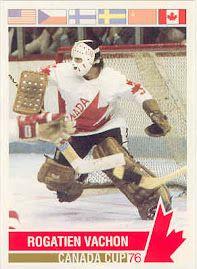
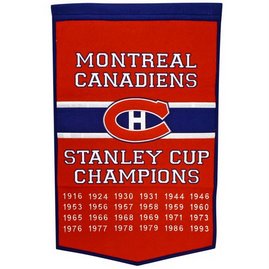







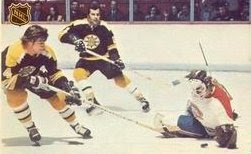



















































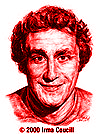



































































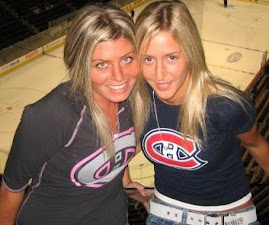


















No comments:
Post a Comment